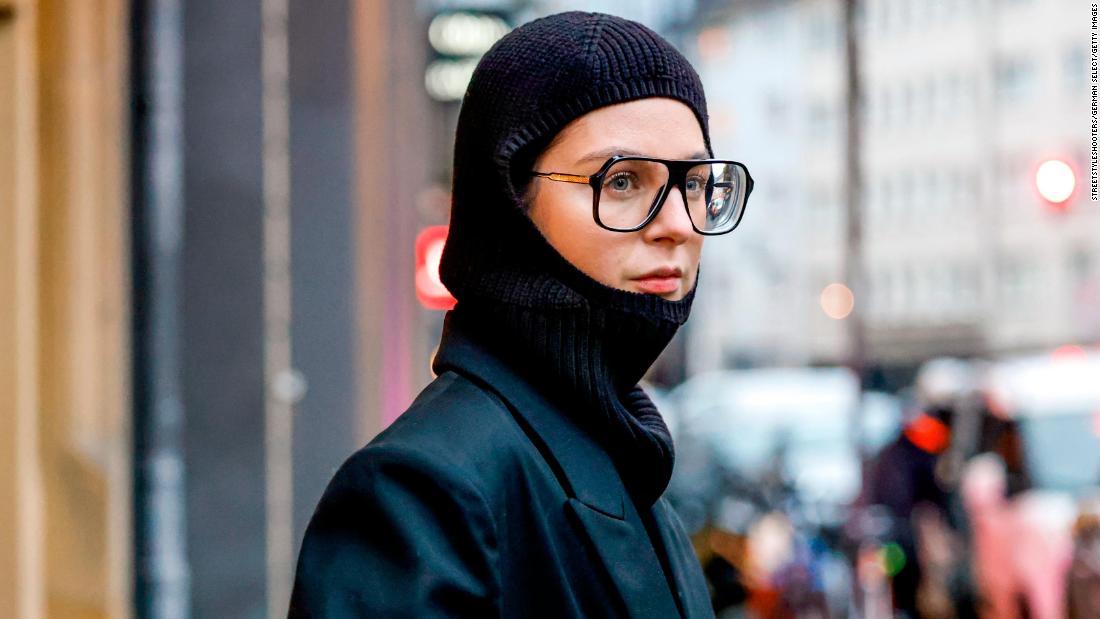Behold the balaclava: Why a 19th-century army accessory has taken over social media - 4 minutes read

Scroll through Instagram, TikTok or Pinterest this winter and you'll see thousands of youthful faces framed inside what looks like an overgrown knitted sock. The balaclava, sometimes called a ski mask, has become an unusual sartorial staple -- and a late entry in the race to claim 2021's hottest fashion trend.
Typically made from wool, mohair or some form of yarn, the headpiece leaves room for a sizable face hole or just for the eyes. On TikTok, at the time of writing, there are 102.6 million videos attached to the hashtag "#balaclava," while another 248,000 people on Instagram have posted about the offbeat accessory. Interest is up on Google too, with the question "how to knit a balaclava" growing more than 5000% in the past 12 months -- likely thanks to Gen Z's favorite pandemic hobby
"Recent balaclava designs from the likes of Stella McCartney all the way through to those now on sale at Zara are fueling the demand among all ages," said Jessica Payne, Pinterest's head of fashion, over email. She noted searches for balaclavas have jumped 230% since the start of November.
The accessory has become a winter favorite, in part because of its convenience in a mask-mandated world. "I think (the trend is) 90% due to the fact that people are more comfortable now having part of their face covered," commented one user on TikTok. "This trend fits so well in the pandemic," another agreed.
But balaclavas were also a mainstay on the runway this year, from the late Virgil Abloh 's hallucinatory checkerboard-style take on the mask, to Givenchy's avant garde twist featuring knitted devil horns. Keen-eyed fashionistas may also remember the accessory from Miu Miu's Paris Fashion week show this past March, where it appeared alongside slip dresses and snow boots against the backdrop of Italy's Dolomite mountains. Balaclavas have also featured in recent collections by Moschino, Balmain, Marine Serre and Raf Simmons before trickling down into brands like Urban Outfitters and Weekday.
So, where did the balaclava come from and how did it capture the imagination of some of the industry's biggest designers?
Historically, the balaclava is more often associated with war tactics than runway trends. These masks take their name from the Ukrainian port town of Balaclava, the backdrop for a battle in 1854 during the Crimean War, where British and Irish troops were sent to fight Russian soldiers in freezing conditions. Morale during the war was low, not least because the UK army arrived with nothing but their worn-out summer uniform. When news of this scandalous lack of supplies traveled back to the UK, British women began knitting full-face hats for their men and shipping them out to the barracks.
According to Rachel Tashjian, GQ's resident fashion critic, the balaclava bubble likely started around this time in 2018 thanks to luxury streetwear label Vetements, co-founded by Georgian designer Demna Gvasalia (known as Demna), who also leads creative direction at Balenciaga. (At the Met Gala this fall, Demna dressed Kim Kardashian West in a black bodysuit and full face mask). At the time, Vetements released a collection accessorized with militant balaclavas and florid silk scarves wrapped around baseball caps.
It was "eastern European style with a 20-year delay," Tashjian said via email. "The attitude of the collection was equal parts menacing and grandma-like, the result of rebuilding flea market garments from other periods into something new."
There's no denying we're experiencing a resurgence in appreciation for Slavic style, with searches for the phrase "Russian aesthetic" peaking on Pinterest in the UK the week of December 7 alone. Nostalgia for post-Soviet culture has also been brewing on social media for the past two years. The hashtag #sovietaesthetic has 4.7 million views on TikTok, filled with videos of young teenagers romanticizing the Brutalist architecture and imagined melancholic ambiance of life after the fall of USSR. Many of the videos were scored by Belarusian synth-pop trio Molchat Doma, who in 2020 shot to fame when their music went viral on the app overnight.
As for the bulky knitted garment currently holding your Instagram feed hostage, it may stick around for the foreseeable future. According to TikTok influencer and trend forecaster Mandy Lee, it ticks multiple boxes, from the "approachable trend" of DIY knitwear, to looking either "apocalyptic" or "glamorous," depending on how it's styled, she said in a video on the app. It's also highly functional in lieu of a winter hat and scarf, she added, which could help extend its lifespan.
"Usually trends that serve a purpose end up lasting longer in the cycle," she commented, adding, "(The balaclava) makes me really excited."
Top image: Influencer Maria Barteczko, wearing a black balaclava beanie by Weekday during a street style shoot on November 19, 2021 in Cologne, Germany.
Source: CNN
Powered by NewsAPI.org